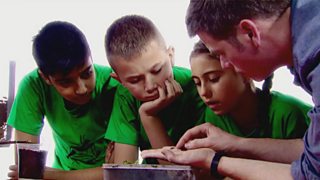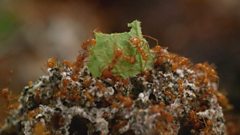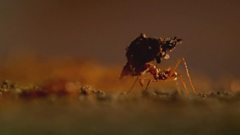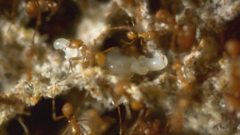
How ants communicate
Professor Adam Hart and four young scientists investigate pheromones and stridulation.
A leafcutter ant colony from Trinidad has been rescued and re-housed in a giant man-made nest in the UK, allowing an in-depth study into their normally hidden world. It鈥檚 the first time a man-made colony has been built on this scale and Professor Adam Hart gives four primary school scientists a tour.
The young scientists learn how ants work as a community and are friendly to each other, communicating using chirping sounds called stridulation. This is a sound made by rubbing two parts of their abdomen together. They use this to communicate where the best leaves are on the plant, and if they are in trouble. Ants also use their antennae to sense different chemicals that other ants lay on the ground; these chemicals are called pheromones.
Back in the lab, Adam focuses the young scientists on different types of communication, testing one of them by blindfolding him and asking him to follow the smell of a lemon.
In the man-made ant colony, Adam gives the ants a test to demonstrate the use of pheromone trails to find food. He creates two different bridges, only one of which leads to food, to find out if and how ants leave and follow pheromone trails.
Duration:
This clip is from
More clips from Life on Planet Ant - Learning Zone
-
![]()
What ants eat and what eats ants
Duration: 04:33
-
![]()
Inside an ant colony
Duration: 02:31
-
![]()
How to build a mini ant nest
Duration: 08:04
-
![]()
Life cycle of an ant
Duration: 04:07





